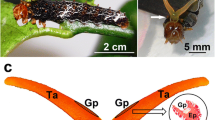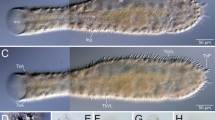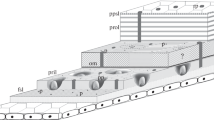Summary
The ultrastructure of the rectal cuticle was studied in eleven species of Insects from nine orders. Special attention was given to those having rectal papillae. In such species, three types of cuticule were observed: 1) the cuticle of the rectal epithelium, 2) the cuticle of the papillae, 3) the cuticle of the border of the papillae.
The cuticle of the border is made of a compact amorphous substance, which is sclerotized and covered by a typical cuticulin layer.
The two other types of cuticle exhibit a more conventional organization, namely the epicuticle comprising both the cuticulin and the dense layer, and the endocuticle. The cuticle of the rectal epithelium is similar to unsclerotized external cuticle. The cuticle of the papillae is more variable and always differs from the cuticle of the rectal epithelium. Variations occur with regards to the cuticulin, the dense layer and the epicuticular filaments. The endocuticle of the papillae has a less conspicuous fibrillar structure which we believe is correlated with the PAS-positive reaction found in this endocuticle. Pore canal sometimes are observed in the cuticle of the rectal epithelium but never above the papillae. In some cases, a sub-cuticular layer containing acid mucopolysaccharids is present in the two types of cuticle.
In species lacking rectal papillae, the rectal wall is covered by only one type of cuticle, the features of which vary according to species.
In some Insects, the cuticle of papillae shows numerous superficial depressions, each of about 0.2 μ in diameter. These “epicuticular depressions” are uniformly distributed throughout the papillae but are not arranged in any particular pattern. We have also found such depressions in other Insects lacking rectal papillae (e.g. Tenebrio). In the epicuticular depressions, the cuticulin exhibits a modified organization and the dense layer is reduced.
The relations between ultrastructure and cuticular permeability are discussed. The possible roles of the cuticulin, the dense layer, the epicuticular filaments and the epicuticular depressions are examined.
Résumé
L'ultrastructure de la cuticule du rectum a été étudiée chez onze espèces d'Insectes, appartenant à neuf ordres. On s'est surtout intéressé aux espèces présentant des papilles rectales; dans ce cas on distingue toujours trois types de cuticule: cuticule de l'épithélium rectal, cuticule des papilles, cuticule du ≪cadre≫ entourant les papilles.
La cuticule du cadre est formée d'une masse compacte et amorphe, sclérifiée, surmontée d'une cuticuline de structure normale.
Les deux autres types de cuticules possèdent une structure plus classique: épicuticule comprenant cuticuline et zone dense, et endocuticule. La cuticule de l'épithélium rectal a toujours une structure comparable à celle d'une cuticule périphérique non sclérifiée. La cuticule des papilles est plus variable, et toujours différente de celle de l'épithélium rectal. Ces différences portent sur la cuticuline, la zone dense, les filaments épicuticulaires; l'endocuticule sur les papilles montre une organisation fibrillaire moins nette, qui paraît corrélative d'une réaction positive à l'APS. Des canaux poraires n'ont jamais été observés dans la cuticule des papilles; il en existe quelquefois dans la cuticule de l'épithélium rectal. Une sous-cuticule, contenant des mucopolysaccharides acides, est présente dans certains cas dans les deux types de cuticule.
Dans les espèces ne possédant pas de papilles rectales, il n'existe qu'un seul type de cuticule rectale, variable suivant l'espèce.
La cuticule des papilles montre, dans certaines espèces, des dépressions superficielles, d'un diamètre voisin de 0,2 μ, réparties uniformément mais sans ordre défini (≪dépressions épicuticulaires≫). De telles dépressions s'observent aussi dans quelques espèces dépourvues de papilles (Tenebrio). Au niveau de ces dépressions, la cuticuline a une structure particulière et la zone dense est réduite.
Les rapports entre structure et perméabilité de la cuticule sont discutés. On envisage en particulier les rôles respectifs de la cuticuline, de la zone dense, des filaments épicuticulaires et des dépressions épicuticulaires.
Similar content being viewed by others
Bibliographie
Anderson, W. A., Ellis, R. A.: Ultrastructure of Trypanosoma lewisi: flagellum, microtubules and the kinetoplast. J. Protozool. 12, 483–499 (1965).
Baccetti, B.: Ricerche sull'ultrastruttura dell'intestino degli insetti. IV: Le papille rettali in un ortottero adulto. Redia 47, 105–118 (1962).
—, Mazzi, V., Massimello, G.: Studio istochimico e al microscopio elettronico dell'ampolla rettale di Dacus oleae Gmel. Redia 48, 265–287 (1963).
Beament, J. W. L.: The effect of temperature on the waterproofing mechanism of an insect. J. exp. Biol. 35, 494–519 (1958).
—: The active transport and passive movement of water in Insects. Advanc. Insect Physiol. 2, 67–129 (1964).
Berridge, M. J., Gupta, B. L.: Fine-structural changes in relation to ion and water transport in the rectal papillae of the blowfly, Calliphora. J. Cell Sci. 2, 89–112 (1967).
—: Fine-structural localization of adenosine triphosphatase in the rectum of Calliphora. J. Cell Sci. 3, 17–32 (1968).
Bordereau, C.: Cuticule intersegmentaire des imagos de Termites supérieurs (Isoptera, Termitidae): Dimorphisms sexuel, ultrastructure, relations avec la physogastrie de la reine. C. R. Acad. Sci. (Paris) 265 (D), 1997–2000 (1967).
Bouligand, Y.: Sur une architecture torsadée répandue dans de nombreuses cuticules d'arthropodes. C. R. Acad. Sci. (Paris) 261, 3665–3668 (1965).
Caveney, S.: Muscle attachment related to cuticle architecture in Apterygota. J. Cell Sci. 4, 541–559 (1969).
Dalton, A. J., Haguenau, F.: The membranes, 223 p. New York and London: Academic Press 1968.
Delachambre, J.: Origine et nature de la membrane exuviale chez la nymphe de Tenebrio molitor L. (Ins. Coleoptera). Z. Zellforsch. 81, 114–137 (1967).
Faasch, W. J.: Darmkanal und Blutverdauung bei Aphanipteren. Z. Morph. Ökol. Tiere 29, 559–584 (1935).
Gabe, M.: Techniques histologiques, 1113 p. Paris: Masson & Cie. 1968.
Grimstone, A. V., Mullinger, A. M., Ramsay, J. A.: Further studies on the rectal complex of the mealworm Tenebrio molitor L. (Coleoptera, Tenebrionidae). Phil. Trans. B 253, 343–382 (1968).
Gupta, B. J., Berridge, M. J.: A coat of repeating subunits on the cytoplasmic surface of the plasma membrane in the rectal papillae of the blowfly, Calliphora erythrocephala (Meig.), studied in situ by electron microscopy. J. Cell Biol. 29, 376–382 (1966a).
Gupta, B. J., Berridge, M. J.: Fine structural organization of the rectum in the blowfly, Calliphora erythrocephala (Meig.) with special reference to connective tissue, trachea and neurosecretory innervation in the rectal papillae. J. Morph. 120, 23–82 (1966b).
Hopkins, C. R.: The fine structural changes observed in the rectal papillae of the mosquito Aedes aegypti L. and their relation to the epithelial transport of water and inorganic ions. J. roy. micr. Soc. 86, 235–252 (1967).
Locke, M.: The cuticle and wax secretion in Calpodes ethlius (Lepidoptera, Hesperidae). Quart. J. micr. Sci. 101, 333–338 (1960).
—: Pore canals and related structures in insect cuticle. J. biophys. biochem. Cytol. 10, 589–618 (1961).
—: The structure and formation of the integument in Insects. In: Rockstein. The physiology of Insecta, vol. III, p. 379–470. New York: Academic Press 1964.
—: Permeability of insect cuticle to water and lipids. Science 147, 295–298 (1965).
—: The structure and formation of the cuticulin layer in the epicuticle of an insect, Calpodes ethlius (Lepidoptera, Hesperidae). J. Morph. 118, 461–494 (1966).
—: The structure of an epidermal cell during the development of the protein epicuticle and the uptake of molting fluid in an insect. J. Morph. 127, 7–39 (1969).
Martoja, R., Cantacuzène, A. M.: Données histologiques sur les mucopolysaccharides acides cuticulaires des Orthoptères. C. R. Acad. Sci. (Paris) 268 (D), 697–700 (1969).
McDunnough, J.: Über den Bau des Darms und seiner Anhänge von Chrysopa perla L. Arch. Naturgesch. 75, 313–360 (1909).
Noble-Nesbitt, J.: Aspects of the structure, formation and function of some insect cuticles. In: J. W. L. Beament, and J. E. Treherne, Insects and physiology, p. 4–16. London: Olivier & Boyd 1967.
Noirot, Ch., Bayon, C.: La cuticule proctodéale des Insectes: Mise en évidence de ≪dépressions épicuticulaires≫ par le microscope électronique à balayage. C. R. Acad. Sci. (Paris) 269 (D) 996–999 (1969).
—, Noirot-Timothée, C.: Mise en évidence d'ultrastructures absorbantes dans l'intestin postérieur des insectes. C. R. Acad. Sci. (Paris) 251, 2779–2781 (1960).
—: Présence de mucopolysaccharides acides dans la cuticule intestinale des insectes. Etude histochimique et ultrastructurale. C. R. Acad. Sci. (Paris), 263 (D), 768–771 (1966a).
—: Revêtement de la membrane cytoplasmique et absorption des ions dans les papilles rectales d'un termite (Insecta Isoptera). C. R. Acad. Sci. (Paris) 263 (D), 1099–1102 (1966b).
—: L'épithélium absorbant de la panse d'un termite supérieur. Ultrastructure et rapport avec la symbiose bactérienne. Ann. Soc. Entomol. France 3, 577–592 (1967).
—: The digestive system. In: K. Krishna, and F. Weesner, Biology of termites, vol. 1, p. 49–88. New York and London: Academic Press 1969a.
- - La cuticule proctodéale des insectes. II: Essai d'histochimie ultrastructurale. En préparation (1969b).
Palm, N. B.: The rectal papillae in insects. Acta Univ. Lund 45, 1–30 (1949).
Pearse, A. G. E.: Histochemistry, theoretical and applied, 2. ed., 998 p. London: Churchill 1961.
Phillips, J. E.: Rectal absorption in the desert locust Schistocerca gregaria Forskal. I: Water; II: Sodium, potassium and chloride; III: The nature of the excretory process. J. exp. Biol. 41, 15–80 (1964).
Quennedey, A.: Les glandes de Gilson des larves de Phryganea varia (Insecta, Trichoptera). Etude histochimique et ultrastructurale. J. Microscopie 8, 479–496 (1969).
Ramsay, J. A.: Excretion by the Malpighian tubules of the stick insect, Dixippus morosus (Orthoptera, Phasmidae): amino acids, sugars and urea. J. exp. Biol. 35, 871–891 (1958).
Reichenbach-Klinke, H. H.: Die Rektalpapillen der Insekten insbesondere der Käfer, und ihre Beziehung zur Stammesgeschichte. Zool. Jb., Abt. Anat. u. Ontog. 72, 230–250 (1952).
Schmidt, E. L.: Observations on the subcuticular layer in the insect integument. J. Morph. 99, 211–226 (1956).
Smith, D. S.: Insect cells, 372 p. Edinburgh: Olivier & Boyd 1968.
Stein, W. D.: The movement of molecules across cell membranes, 369 p. New York and London: Academic Press 1967.
Stobbart, R. H.: Ion movements and water transport in the rectum of the locust Schistocerca gregaria. J. Insect. Physiol. 14, 269–275 (1968).
Strambi, C., Zylberberg, L.: Données morphologiques sur l'ampoule rectale de Troglodromus bucheti gaveti S. C. D. (Coléoptère, Bathysciinae). Ann. Sci. nat. Zool. 9, 529–548 (1967).
Taylor, R. L., Richards, A. G.: Integumentary changes during moulting of arthropods with special reference to the subcuticle and ecdysial membrane. J. Morph. 116, 1–21 (1965).
Wessing, A.: Funktionsmorphologie von Exkretionsorganen bei Insekten. Zool. Anz. (Suppl.) 31, 633–681 (1968).
Wigglesworth, V. B.: On the function of the so-called “rectal glands” of insects. Quart. J. micr. Sci. 75, 131–150 (1932).
—: The principles of insects physiology, 6. ed. London: Methuen & Co. 1965.
Author information
Authors and Affiliations
Rights and permissions
About this article
Cite this article
Noirot, C., Noirot -Timothée, C. La cuticule proctodéale des Insectes. Z.Zellforsch. 101, 477–509 (1969). https://doi.org/10.1007/BF00335265
Received:
Issue Date:
DOI: https://doi.org/10.1007/BF00335265




